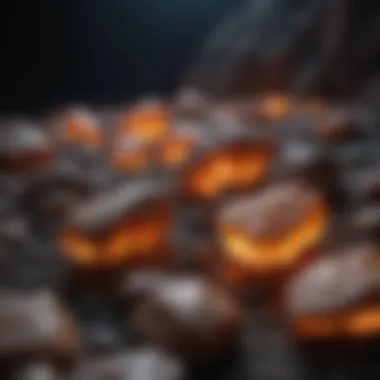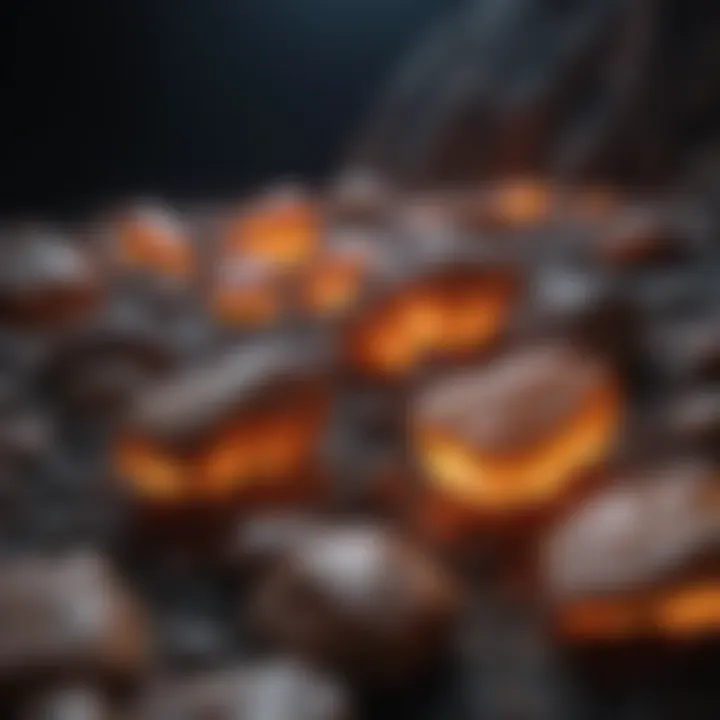The Fascinating World of Luminescent Rocks Explained


Intro
In the celestial dance of our planet’s geological wonders, luminescent rocks stand out like beacons in the night. These natural marvels captivate not just the eye, but also the imagination, fusing science with artistry. Their ability to emit light, often in ethereal colors, speaks of processes deep within the Earth’s crust, where minerals meet heat and pressure in a perfect cocktail of reactions.
Collectively, people often turn to these luminescent treasures as both collectibles and sources of enchantment. This guide seeks to explore the intricacies of these glowing stones, starting with the jewels of the month.
Featured Collectible of the Month
Overview
Every month, a special luminescent rock is spotlighted for enthusiasts. This month, we shine the light on the Fluorescent Calcite. This rock isn’t just a pretty face; its vibrant colors under ultraviolet light make it a favorite among collectors.
Fluorescent Calcite comes in various shades, with deep oranges, yellows, and greens popping with incredible intensity when exposed to blacklight. Its unique ability to absorb energies and emit glowing hues adds a layer of mystique, making it not only an aesthetic piece but also a scientific curiosity.
Historical Significance
Historically speaking, Fluorescent Calcite has made its mark in the world of mineralogy. As far back as the late 19th century, scientists began to document its remarkable properties. Notably, the term "fluorescence" itself was conceived due to this mineral and its captivating glow.
From ancient civilizations who marveled at such glimmering stones to modern-day collectors, this rock bridges the ages, symbolizing the unbroken thread of human curiosity about the natural world.
Identification Techniques
Visual Characteristics
Identifying luminescent rocks requires more than just a glance. Observing key visual characteristics is essential. Here are a few pointers:
- Color: A diverse palette ranging from luminescent reds to tranquil blues is common.
- Texture: Look for smooth, glassy surfaces; this often indicates high-quality specimens.
- Light Emission: Not all luminescent rocks glow under natural light. Use a blacklight to unveil their hidden beauty.
Resources for Identification
For those keen on identifying luminescent rocks, several resources are invaluable:
- Check out the detailed guides on Wikipedia for mineral properties.
- Engage with fellow collectors on platforms like Reddit and share your finds.
- Facebook groups dedicated to rock and mineral enthusiasts can also be great for tips and tricks.
"The world of luminescent rocks is not just about aesthetics; it’s a field rich with scientific significance and cultural relevance."
Preface to Luminescent Rocks
The allure of luminescent rocks draws many to explore their fascinating characteristics, standing out in the geological world. As nature's own form of artwork, they captivate not only geologists but also enthusiasts and collectors from all walks of life. These rocks, which emit light through various processes, go beyond mere aesthetics; they offer insights into the history and formation of our planet.
Definition of Luminescence
Luminescence refers to the phenomenon where certain materials emit light when excited by energy sources like heat, electric fields, or radiation. Unlike incandescence, which is light emitted due to high temperatures, luminescence occurs at lower temperatures and can happen in various environments. Its role in geology is multifaceted, providing essential knowledge about mineral properties and their origins.
The Spectrum of Luminescent Types
Understanding the different types of luminescent reactions is pivotal for appreciating the broader topic of luminescent rocks.
Fluorescence
Fluorescence is the most commonly recognized form; it occurs when a mineral absorbs light or other electromagnetic radiation and then quickly re-emits it. This reaction can take place in just nanoseconds after exposure. The capabiility of minerals like fluorite to glow in vibrant colors under UV light makes fluorescence a fascinating subject for study. This immediacy and visibility is what draws many to fluorescence, emphasizing its immediate, striking appeal in dark environments.
However, the main drawback is its transient nature. Once the stimulating energy is removed, the luminescence ceases, leaving the rock looking just like any other. This ephemeral quality might limit its allure for long-term collectors who seek more permanent displays.
Phosphorescence
Phosphorescence is akin to fluorescence, but here’s the hitch—it continues to glow long after the energy source has been removed. The most common example is the mineral strontium aluminate, which can emit light for hours. This quality creates an enchanting experience, particularly in darker settings, contributing to its popularity among collectors and artists alike.
Phosphorescent materials are often sought after for their ability to create striking visual effects. Yet, sourcing these minerals can be difficult, and not every specimen is capable of demonstrating this property well, which poses a challenge for collectors hoping to find standout pieces.
Chemiluminescence
Chemiluminescence involves a chemical reaction that produces light. It's famously recognized in glow sticks, where a chemical process creates a glow without any heat. In nature, it’s less common but can be seen in certain organisms such as fireflies or specific fungi, which can offer fascinating insights into biological interactions with rocks and minerals.
This type of luminescence is ideal for illustrating the intersection of geology and biology, showcasing how different life forms can utilize earth’s materials. Its unique aspect makes chemiluminescence invaluable in teaching about natural phenomena, yet it can be a challenge for collectors, as finding naturally occurring chemiluminescent minerals is quite rare.
Geological Origins of Luminescent Rocks


Understanding the geological origins of luminescent rocks is essential when exploring their beauty and scientific significance. These unique stones not only share their mesmerizing glow with us but also tell a tale of their formation — a tale written in the pages of Earth's history. Knowing how these rocks form can deepen our appreciation for the natural processes that create such wonders.
Mineral Composition and Coloration
At the core of luminescent rocks is their mineral composition. Certain minerals possess the ability to emit light when excited by various energy sources, such as UV radiation. Common culprits include minerals like calcite, which may exhibit fluorescence under UV light, or barite, which might show a striking blue shade in the same conditions. As you sift through your collection or dig through a rocky outcrop, recognizing these specific minerals can open a window into understanding the rock's luminescent properties.
But it isn’t just the presence of certain minerals that dictates color and luminescence. The presence of trace elements alters how these minerals react when illuminated. For example, the presence of manganese might create pink fluorescence in calcite, while iron can temper the color within quartz. Each luminescent rock can thus be considered an archive of its mineral makeup and coloring—reminding collectors that beauty often lies in the details of composition.
Environmental Influences
Environmental factors also play a pivotal role in shaping luminescent rocks. Geological conditions such as temperature, pressure, and the presence of unique environmental catalysts influence how and if luminescence occurs. For example, sedimentary rocks formed in a low-energy freshwater environment often develop specific luminescent characteristics that differ from those formed in high-energy marine settings.
Natural radiation from the surrounding environment can enhance or diminish luminescent properties over time. As rocks undergo processes, like erosion or tectonic shifts, their luminescent features may change—either revealing or concealing the glow.
A good example comes from the Great Lakes region in North America, where certain limestones exhibit stunning fluorescence thanks to the specific geological conditions present during their formation. This illustrates the delicate balance between a rock's makeup and its environment, creating a complex relationship that every collector should appreciate.
"The luminescence of a mineral often hints at its journey through time — a captivating story of elements, conditions, and processes playing out on Earth's canvas."
In summary, both the mineral composition and environmental influences of luminescent rocks are fundamental in understanding their geological origins. For collectors and enthusiasts alike, delving into these origins enriches the experience, transforming simple admiration for their glow into a profound connection with the story of our planet.
Discovering Luminescent Rocks
The charm of luminescent rocks lies not just in their ethereal glow but also in the adventure of discovering where they can be found. Many enthusiasts find that the thrill of the hunt contributes to their passion for collecting these natural wonders. Understanding where to look and how to identify them is crucial for any dedicated rock hunter or collector. This section explores vital locations and identification methods, equipping readers with the knowledge they need to delve deeper into the world of luminescent rocks.
Locations for Finding Luminescent Rocks
Lurking in places where natural processes have been at work, luminescent rocks can often be found in certain geological settings. Here’s a look at some key locations:
- Caves and Caverns: Many types of luminescent minerals thrive in dark, damp environments. Caving expeditions, especially in limestone caves, can yield stunning finds.
- Volcanic Regions: Lava flows can create rocks that exhibit luminescence. Scoria and pumice are two examples; both can be fascinating to collect.
- Riverbeds and Streambanks: Erosion often reveals luminescent stones in these areas. Panning for rocks can be particularly rewarding after a heavy rain.
- Fault Zones: Areas where tectonic activity is evident could also host luminescent minerals. Collecting in these regions can sometimes feel like hunting for buried treasure.
Whether embarking on field trips, joining local geological societies, or hiking through untouched landscapes, knowing the right places to look can make all the difference.
Methods for Identification
Identifying luminescent rocks can be straightforward with the right techniques. Two popular methods stand tall in this arena: visual inspection and UV light testing.
Visual Inspection
Visual inspection involves a careful examination of the rock’s characteristics. The goal is to catch clues in its color patterns, texture, and overall appearance. Here’s why this method stands out:
- Key Characteristic: Luminescent rocks often display unique features such as bright colors or a waxy sheen—give it a good look, and you might just spot something special.
- Accessibility: This method is incredibly popular because it requires no special equipment; just your own two eyes.
- Advantages: You can quickly assess a large number of samples by simply looking at them. However, it is worth noting that some luminescent traits might be subtle and can easily be missed without practice.
Visual inspection isn't foolproof but can lay a great foundation for collectors who are just beginning their journey.
UV Light Testing
On the other hand, UV light testing adds a layer of sophistication to the identification process. This method utilizes the characteristics of fluorescence to highlight luminescent properties that are otherwise hidden under normal light. Here’s what makes UV light testing noteworthy:
- Key Characteristic: When exposed to ultraviolet light, many minerals will fluoresce, sometimes in vibrant greens, blues, or pinks. This glow makes it fairly straightforward to spot gems at a glance.
- Precision: This method is favored for its accuracy; it reduces the chances of misidentifying dull rocks that lack luminescence.
- Disadvantages: While powerful, this technique does require access to UV light sources, which might not always be feasible for every collector. Additionally, taking the time to handle rocks with care under UV can take a bit more effort.
In short, while both visual inspection and UV light testing serve their purpose well, determining which method works best may come down to the collector's comfort level, skills, and available tools.
Finding and identifying luminescent rocks can transform a simple hobby into an adventure of discovery. Each glow tells a story of the earth's history, waiting to be explored.
Scientific Significance of Luminescent Rocks
Understanding luminescent rocks goes beyond mere aesthetic appreciation. They serve remarkable roles in both geological and paleontological sciences, offering insights that enhance our knowledge of Earth's history and natural processes. By studying these unique rocks, we dive deeper into the mysteries of our planet’s past while also harnessing their properties for various practical applications.
Applications in Geology and Paleontology
In geology, luminescent rocks are not just pretty objects; they’re critical for interpreting the formation processes of minerals and the conditions under which they formed. For example, specific luminescent characteristics can help identify the mineral composition. Fluorescent minerals, when exposed to UV light, can reveal details about the elemental make-up of the rock, drawing a direct line to the geological conditions during crystallization. These attributes assist geologists in mapping out past environmental conditions, helping us understand changes in climate over millions of years.
“Luminescent properties of minerals can point towards significant geological events—almost like whispers of the Earth’s history.”
In paleontology, luminescent rocks play an invaluable role in dating sediment layers where fossils are found. By applying methodologies such as optically stimulated luminescence and thermoluminescence, researchers can obtain age estimates for sediment, which further informs our understanding of the timing of evolutionary processes.
Luminescence in Dating Techniques
Optically Stimulated Luminescence


Optically Stimulated Luminescence (OSL) is a powerful technique for dating sediments. The method measures the last time mineral grains were exposed to sunlight. When these minerals are buried, they accumulate trapped energy from radioactive decay, which can be released when stimulated by light. Its key characteristic lies in its precision; OSL can date materials from a few decades to several hundred thousand years old, making it a popular choice among geologists.
One of the unique features of OSL is its reversibility; this technique can be repeated multiple times on the same sample. This allows scientists to refine their age estimations as new techniques evolve or new sites are analyzed. However, the primary disadvantage is that the conditions of burial need to be understood well, as disturbances can result in inaccurate ages.
Thermoluminescence
Thermoluminescence (TL) offers another approach to dating, albeit with slightly different parameters. It measures the stored energy from radioactive decay released as light when the material is heated. This method is particularly beneficial for dating ceramics, sediments, and certain types of rock. TL can provide age estimates in a similar time frame as OSL, often dating back to several hundred thousand years.
A unique aspect of TL is that it can be applied to materials that can’t be dated conventionally. This makes it advantageous for archaeological digs where the context might be compromised. On the flip side, variations in environmental conditions—like moisture and temperature—can impact results, which is a critical consideration during interpretation.
In summary, the scientific significance of luminescent rocks cannot be overstated. They form a crucial link between the geological processes that shape our planet and the biological history recorded in its layers. Their vibrant colors and illuminating properties not only capture our imagination but also provide invaluable tools for understanding the intricacies of Earth’s history.
Cultural Impact of Luminescent Rocks
The allure of luminescent rocks extends beyond the confines of scientific inquiry and geological contemplation. This section sheds light on the cultural significance of these unique formations, examining their influence on history, art, and modern society. Understanding the cultural impacts can enrich our appreciation of luminescent rocks, highlighting their multifaceted presence in human life.
Historical Perceptions
Historically, luminescent rocks have captured the imagination of many cultures across the globe. In ancient times, some populations believed that these glowing stones possessed magical properties. For instance, in certain Native American traditions, luminescent mineral formations were thought to be the dwelling places of spirits, often used in rituals meant to invoke safety and prosperity. Similarly, in Asian medicine, specific luminescent crystals were believed to hold curative powers.
Various civilizations linked luminescence to a divine or supernatural significance. In medieval Europe, alchemists experimented with stones that glimmered under candlelight, viewing them as potential conduits for transformation and enlightenment. Citations of glowing stones appear in folklore as tokens of good fortune or as omens of impending change, shaping the perception of these geological wonders as symbols of mystique.
The perception hasn’t aged like fine wine; rather it has evolved but continues to resonate today. People treasure the enchanting glow of these rocks not just for their aesthetic beauty, but also for the stories they tell about ancient beliefs and practices. The rich tapestry of historical narratives woven around luminescent rocks deepens their cultural significance, bridging past and present.
Modern Uses in Art and Design
In contemporary society, luminescent rocks find their place not just in collections but as striking elements in art and design. They are frequently used in various forms of artistic expression, from sculptures to jewelry, providing a refreshing take on traditional materials. Artists blend natural luminescence with modern aesthetics, creating visually arresting pieces that speak to both the beauty of nature and human creativity.
In interior design, luminescent rocks light up spaces, creating atmospheric effects. Designers use them to craft unique lighting installations or as decorative accents that lend an otherworldly glow to spaces. Sculptures made from such rocks can transform a mundane outdoor area into a captivating visual experience, enticing viewers to engage with their surroundings.
Moreover, luminescent minerals often serve practical functions. For instance, some artists and designers integrate them into functional items, such as lamps or outdoor artworks that not only enchant but also illuminate paths or gardens at night. As seen in contemporary galleries and exhibitions, these stones have taken a central role in promoting sustainability and environmental consciousness in art.
"Luminescent rocks embody the merging of nature and creativity, creating a dialogue between the past and modern artistic expressions."
In summary, the cultural narrative surrounding luminescent rocks has beautifully evolved. It encompasses historical beliefs and modern artistic pursuits, reflecting a gradual, yet profound, appreciation for these geological marvels. Collectors and enthusiasts are not merely gathering stones; they partake in a rich history and an ongoing story that continues to unfold into various realms of cultural significance.
Collecting Luminescent Rocks
Collecting luminescent rocks can be one of the most fascinating endeavors for rock and mineral enthusiasts. It combines a passion for geology with the excitement of discovering unique natural phenomenon. The appeal goes beyond the visual allure; it dives into the science and the stories behind each rock.
For collectors, luminescent rocks offer a chance to own not just pieces of the earth but also specimens that are often steeped in history and cultural significance. Finding these stunning materials may connect collectors to a world of art, history, and the natural sciences. However, there are key elements, benefits, and considerations to keep in mind.
Ethical Considerations
When collecting luminescent rocks, the ethical implications should always be at the forefront. The thrill of finding a glowing rock shouldn't overshadow responsible collecting practices.
- Respect Nature: Always be mindful of the environment. Only collect rocks in areas that allow for it, avoiding protected sites.
- Local Regulations: Know the laws regarding rock collecting in your area. Some places may have restrictions that could lead to legal repercussions if ignored.
- Leave Some Behind: It’s tempting to take as many samples as one can find, but leaving behind some specimens helps preserve ecological balance and allows others to experience the same joy of discovery.
- Support Local Communities: If possible, purchase luminescent rocks from local sources rather than collecting them yourself. This can foster sustainable practices and support local economies.
"Collecting responsibly not only preserves the beauty of our planet but enriches the collector’s experience."
Storage and Care Tips
Once you've successfully gathered luminescent rocks, the next step is to ensure they are stored and cared for appropriately, maintaining their beauty and integrity.
- Avoid Direct Sunlight: Prolonged exposure to sunlight can fade the luminescence and damage the rocks. Store them in a cool, dark place.
- Use Soft Cloths for Cleaning: When cleaning, avoid harsh chemicals. A soft cloth, or a gentle brush, works wonders without causing scratches.
- Display Strategically: If showing off your collection, consider using UV light to enhance visibility without directly exposing them to damage from regular light.
- Container Choice: Opt for protective containers that shield your rocks from physical wear and dust. Plastic boxes or glass display cases can be excellent choices.
- Recording Details: Keep notes about each rock, including where it was found and any associated stories. This documentation can greatly enhance its value and your enjoyment.
Fostering a responsible approach to collecting can deepen your appreciation and contribute positively toward the field as a whole.
Market Trends and Valuation
The exploration of luminescent rocks not only captivates the curiosities of collectors and enthusiasts, but also graces an intriguing market dynamic. Understanding current trends and valuation models for luminescent rocks is essential, especially for collectors aiming for substantial investments. Several elements play pivotal roles within this niche market, revealing the complex interplay of rarity, quality, and provenance that shapes the valuation of these geological treasures.
Current Market for Luminescent Rocks
Today, the market for luminescent rocks appears bright. With growing interest among collectors, as well as an expanding array of applications—from artistic endeavors to educational purposes—the demand continues to climb. This increase is also influenced by social media platforms where enthusiasts share their finds, thus promoting the beauty and unique attributes of these rocks.
- Collectors often spotlight unusual finds—like those that glow in response to UV light—adding a layer of excitement and desirability.
- Auction houses are beginning to recognize the uniqueness of luminescent specimens, showcasing them in specialized events. The engagement at these auctions indicates a burgeoning appreciation and valuation increase for certain items.


Factors Influencing Value
Rarity
The concept of rarity plays a significant role in determining the worth of luminescent rocks. When a specimen is tough to come by due to geological or historical factors, its value tends to increase substantially. Unique formations from limited locations offer not just a physical attribute but also a narrative that captivates buyers.
- Key Characteristic: The less common the luminescent mineral, the more coveted it becomes. For example, a rare light-blue calcite with phosphorescent properties can catch a collector’s eye quickly.
- Unique Feature: Not all luminescent rocks glow under the same conditions. The more versatile the luminescence—like those reacting differently to light or temperature—the more appealing the piece becomes. However, with rarity comes limited availability, which can drive prices sky-high without guarantee of future market turnover.
Quality
Quality, too, is essential in the valuation spectrum of luminescent rocks. The purity of the mineral, clarity, and brilliance of the luminescent glow contribute substantially to its appeal. Collectors often assess quality based on both aesthetic and physical properties.
- Key Characteristic: High-quality specimens demonstrate vibrant colors and stable luminescence. For instance, a deep-red fluorite specimen that glows with intensity is generally more sought-after than a duller variant.
- Unique Feature: However, a common issue arises—high-quality specimens can be more fragile, often leading to concerns about damage during handling or display. Hence, while valuable, these specimens demand careful stewardship from collectors.
Provenance
When it comes to luminescent rocks, provenance refers to a rock’s history and previous ownership. A well-documented origin can add to the item’s allure and monetary value, linking it to specific regions known for their luminescent discoveries.
- Key Characteristic: Rocks sourced from renowned locations—where geological conditions foster unique luminescent properties—often fetch higher prices than those with vague origins.
- Unique Feature: Provenance enhances storytelling aspects around a luminescent specimen, offering potential collectors not just a stone but a piece of geological history. Buyers typically seek reliable documentation to support claims of uniqueness and authenticity.
Collecting luminescent rocks is more than a hobby; it’s an investment in nature’s artistry and a gateway into the connectedness of earth's history and culture.
In summary, understanding the nuances of market trends and valuation for luminescent rocks equips both new and seasoned collectors with knowledge that transcends mere aesthetics. By focusing on rarity, quality, and provenance, individuals can make informed decisions, enhancing their collection's potential both for personal satisfaction as well as financial gain.
Scientific Research and Future Directions
The realm of luminescent rocks is not just a treasure trove for collectors but also a fertile ground for scientific research. As the fascination with these unique geological formations continues to grow, so do the inquiries into their underlying mechanisms and potential applications. Understanding the significance of scientific research in this area can open pathways for both innovations and a deeper appreciation of these natural wonders.
Emerging Research Areas
Recent studies have spotlighted various research areas that seek to unravel the mysteries of luminescent rocks. For instance, researchers are delving into the mineralogical aspects of luminescence. They are examining specific minerals such as barite, calcite, and fluorite, which exhibit distinct luminescent properties under different conditions. The analysis includes:
- Microstructural Studies: Investigating the crystal structure to understand how impurities and defects play a role in luminescence.
- Environmental Factors: Studying how temperature, pressure, and radiation affect luminescent behavior, providing insights into geological processes.
- Ecological Implications: Understanding how luminescence can influence ecosystem dynamics, particularly in regions with high mineral diversity.
Researchers are also exploring sustainability in collecting and utilizing luminescent rocks, aiming to balance appreciation and conservation. This dual focus can help ensure that geological treasures are not subjected to over-harvesting.
"As we deepen our understanding of luminescence, we nurture both curiosity and responsibility toward these natural artifacts."
Technological Advances in Study
The investigation of luminescent rocks has been significantly enhanced by technological developments. Groundbreaking tools are paving new roads in the field of geology. Some noteworthy advances include:
- Spectroscopic Techniques: The development of sophisticated spectrometers allows scientists to analyze light emissions with greater precision. These devices help identify specific wavelengths and energy levels emitted by luminescent minerals, leading to a better understanding of their chemical properties.
- Imaging Technology: High-resolution imaging techniques provide detailed views of luminescent patterns. Using scanning electron microscopes (SEM) and confocal laser scanning microscopy, scientists can visualize the structures of luminescent minerals at a microscopic level.
- Geophysical Methods: Innovations in geophysical surveys are also benefiting the study of luminescent rocks. Techniques such as ground-penetrating radar (GPR) are proving useful for locating subsurface deposits with luminescent characteristics, making exploration more efficient.
Such advancements not only enhance research capabilities but also facilitate broader public engagement with luminescent rocks. By painting a clearer picture of how these rocks form and function, scientists can intrigue and educate both collectors and enthusiasts alike.
Ending: The Lasting Appeal of Luminescent Rocks
The allure of luminescent rocks endures through ages, bridging the worlds of science, culture, and personal passion. These natural wonders not only captivate the eye but also provoke thought regarding their formation and the intricate processes that create such beauty. They serve as a testament to the Earth's geological history and the ongoing evolvement of our environment. The significance of this topic in the article reflects a nuanced understanding of how these rocks embody both aesthetic appeal and scientific intrigue.
Luminescent rocks are more than just visually striking; they're embedded with stories of the Earth's past and pivotal moments of geological transformations. Whether it’s the vibrant fluorescing minerals that light up under ultraviolet rays or those that smoothly glow in the darkness, each example provides insight into the history of our planet. Understanding these elements ultimately enhances the appreciation of the natural world.
Moreover, the engagement with luminescent rocks fosters a community among collectors and enthusiasts who share an intrinsic curiosity for these specimens. This collective passion fuels further exploration and study, allowing for a continuous loop of discovery and education that benefits both individuals and the field of geology at large.
"In the realm of collecting, luminescent rocks shine bright, offering not just pieces of earth but fragments of wonder."
Reflection on Their Natural Beauty
The natural beauty of luminescent rocks can be described as enchanting in the truest sense. Their ability to emit light adds another layer to the visual feast they provide. When the sun sets and darkness wraps around the environment, these rocks reveal their true character, casting a captivating glow that can stir emotions and ignite imaginations. The stunning colors range from the ethereal blues to captivating greens and fiery oranges, each hue telling a story of its unique mineral makeup and geological journey.
Collectors often feel a deep connection to luminescent rocks, drawn to their physical beauty and the tales they whisper of natural processes. It’s not simply the sight of a vivid mineral under a UV light that draws someone in; it’s the narrative behind its creation, the atmosphere of the geological environment, and the interplay of light and dark that encapsulates the essence of nature itself.
In recent years, artists have also started to take notice of these glowing gems. Some have incorporated luminescent materials into their work, producing art pieces that evoke wonder and highlight the marriage of nature and human creativity. This brings further appreciation into how luminescent rocks can traverse beyond mere collectibles to sources of inspiration.
Encouraging Responsible Collecting
As the demand for luminescent rocks rises, the importance of responsible collecting cannot be overstated. Collectors must prioritize sustainability and ensure that their passion does not lead to detrimental impacts on local ecosystems or geological sites. Before embarking on a collecting venture, it’s crucial to do due diligence on the area and adhere to any regulations or guidelines established for collecting. Accessing minerals from designated areas rather than disturbing rare sites helps preserve the very essence of what makes these materials special.
Additionally, promoting educational outreach through workshops or community efforts can uplift awareness regarding the ethical collection of these rocks. Collectors can set examples by sharing best practices and how to minimize their carbon footprint while indulging in their hobbies.
Some practical tips for responsible collecting include:
- Researching Local Laws: Always be in the know about what is permitted in your region regarding rock collecting.
- Avoiding Sensitive Areas: Stay away from protected sites or habitats that could be disrupted.
- Joining Collecting Clubs: Many clubs promote sustainable practices and can guide responsible collecting.
By encouraging responsible practices, each collector not only finds joy in their newfound rocks but also contributes to the overall integrity and longevity of luminescent rock collecting as a discipline. Our collective efforts can ensure that future generations of enthusiasts can explore and marvel at these natural wonders.



